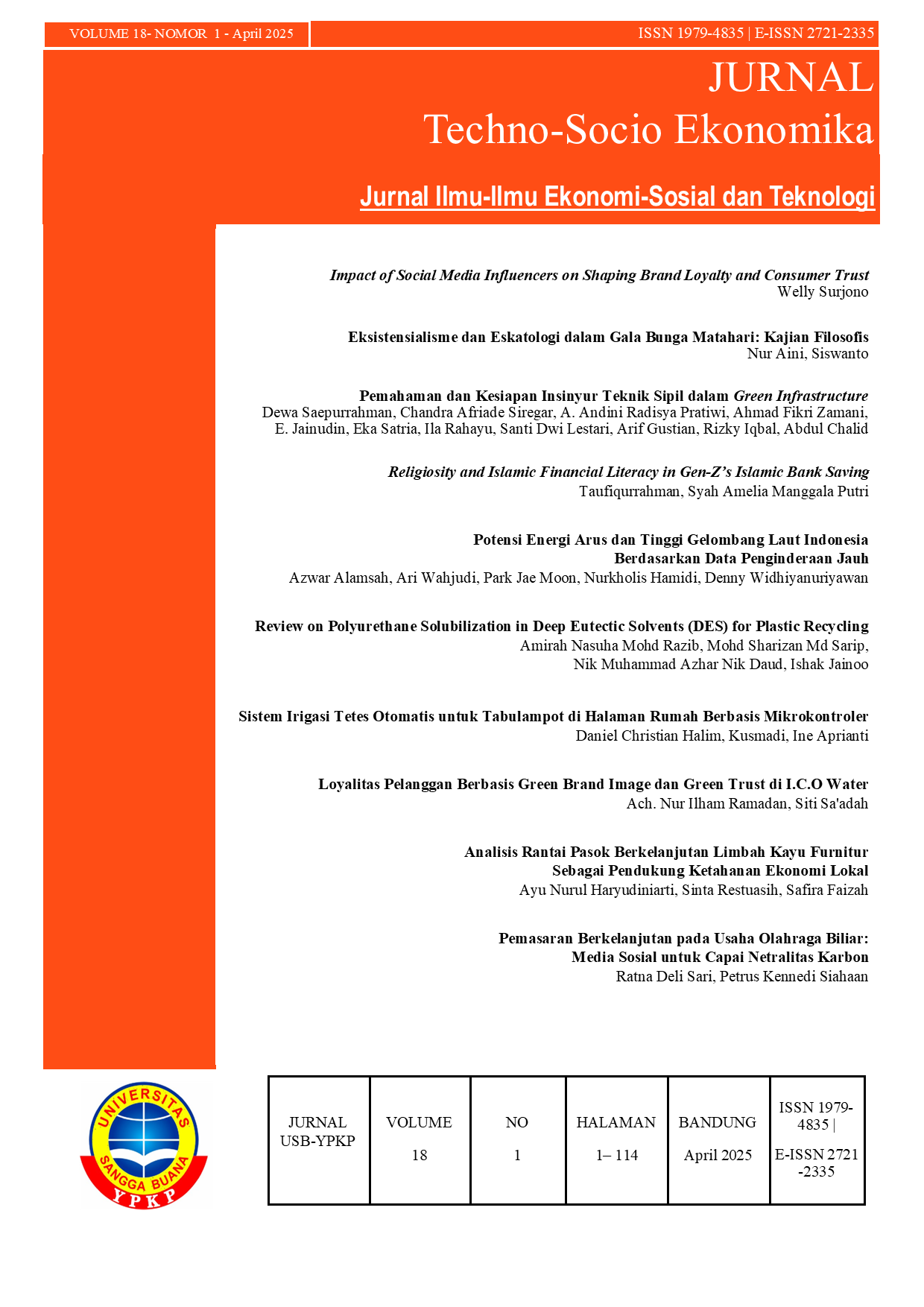Potensi Energi Arus dan Tinggi Gelombang Laut Indonesia Berdasarkan Data Penginderaan Jauh
Isi Artikel Utama
Abstrak
Kebutuhan energi di Indonesia terus meningkat, dengan ketergantungan utama pada bahan bakar fosil yang menimbulkan masalah lingkungan, seperti peningkatan emisi CO2. Untuk mengatasi tantangan ini, penelitian ini mengeksplorasi otensi energi terbarukan dari sumber tinggi gelombang dan arus laut. Proses penelitian ini menganalisis potensi energi yang dihasilkan dari gelombang dan arus laut di seluruh wilayah Indonesia menggunakan metode WAVEWATCH-III untuk memodelkan data laut selama 10 tahun, menganalisis potensi energi dilokasi strategis di perairan Indonesia. Hasil penelitian menunjukkan bahwa potensi energi dari arus laut berkisar antara 120-150 kW, dengan lokasi-lokasi strategis di sekitar selat, seperti Selat Makassar dan Laut Jawa. Sementara itu, potensi energi dari gelombang laut mencapai sekitar 2,5 GW dalam periode tiga bulan, berkat panjang garis pantai Indonesia yang mencapai 99.093 km. Analisis spasial dan temporal mengungkapkan variasi signifikan dalam nilai Anomali Tingkat Permukaan Laut (SLA), yang dapat dimanfaatkan untuk pengembangan proyek energi terbarukan. Kesimpulan dari penelitian ini menekankan perlunya pemahaman yang lebih dalam tentang dinamika arus laut dan gelombang untuk memaksimalkan pemanfaatan potensi energi terbarukan di Indonesia. Spasial dan temporal menunjukkan variasi signifikan dalam nilai Sea Level Anomaly (SLA) di Indonesia, yang mencerminkan dinamika arus laut. Pemahaman tentang perubahan ini penting untuk perencanaan proyek energi arus laut yang adaptif, dan analisis tren musiman dapat membantu mengoptimalkan pemanfaatan pola arus laut.
Rincian Artikel

Artikel ini berlisensi Creative Commons Attribution-NonCommercial-NoDerivatives 4.0 International License.
Penulis memegang hak cipta dan memberikan jurnal hak penerbitan pertama dengan karya yang dilisensikan secara bersamaan di bawah Creative Commons Attribution 4.0 International License yang memungkinkan orang lain untuk berbagi karya tersebut dengan pengakuan atas kepengarangan karya dan publikasi awal dalam jurnal ini.
Referensi
ESDM. Rencana Usaha Penyediaan Tenaga Listrik PT Perusahaan Listrik Negara (Persero) tahun 2015-2024. Jakara: ESDM; 2015.
Allen J, Iglesias G, Greaves D, Miles J. Physical modelling of the effect on the wave field of the wavecat wave energy converter. J Mar Sci Eng. 2021;9(3).
Sutikno T, Purnama HS, Subrata AC, Pamungkas A, Arsadiando W, Wahono T. KONVERSI ENERGI: MANAJEMEN, PRINSIP, DAN APLIKASI. Asyhari B, editor. Yogyakarta: UAD PRESS; 2021.
Zhou Y. Eco- and Renewable EnergyMaterials. Beijing: Springer; 2013.
Silva D, Bento AR, Martinho P, Guedes Soares C. Corrigendum to “High resolution local wave energy modelling in the Iberian Peninsula” [Energy 91 (2015) 1099-1112]. Energy [Internet]. 2016;94:857–8. Available from: http://dx.doi.org/10.1016/j.energy.2015.11.033
López I, Pereiras B, Castro F, Iglesias G. Holistic performance analysis and turbine-induced damping for an OWC wave energy converter. Renew Energy. 2016;85:1155–63.
Bosserelle C, Reddy S, Krüger J. Waves and Coasts in the Pacific : Cost analysis of wave energy in the Pacific. Fiji: SCP; 2015.
Besio G, Mentaschi L, Mazzino A. Wave energy resource assessment in the Mediterranean Sea on the basis of a 35-year hindcast. Energy [Internet]. 2016;94:50–63. Available from: http://dx.doi.org/10.1016/j.energy.2015.10.044
Astariz S, Iglesias G. Co-located wind and wave energy farms: Uniformly distributed arrays. Energy [Internet]. 2016;113:497–508. Available from: http://dx.doi.org/10.1016/j.energy.2016.07.069
EPRI. Mapping and Assesment of the United States Ocean Wave Wave Energy Resources. Palo Alto: EPRI; 2011.
Yuningsih A, Saputra MD. Assessment of Potential Marine Current Energy in the Straits of the Lesser Sunda Islands Kajian Potensi Energi Arus Laut Di Selat-Selat Kepulauan Sunda Kecil. Bull Mar Geol. 2021;36(1):27–36.
Wang S, Yuan P, Li D, Jiao Y. An overview of ocean renewable energy in China. Renew Sustain Energy Rev [Internet]. 2011;15(1):91–111. Available from: http://dx.doi.org/10.1016/j.rser.2010.09.040
Anggraini TS, Santoso C. Development of ocean renewable energy model in indonesia to support eco-friendly energy. Int Arch Photogramm Remote Sens Spat Inf Sci - ISPRS Arch. 2023;48(M-3–2023):1–5.
Langodan, S., Viswanadhapalli, Y., Dasari, H. P., Knio, O., & Hoteit I. Applied Energy. 2016;181, 244–2.
Fraenkel P. Power from Marine Currents. J Power Energy. 2001;216(A1):1–14.

